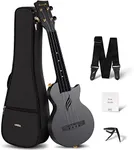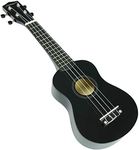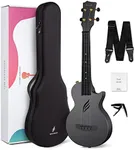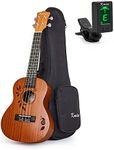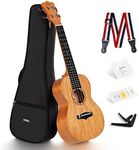Buying Guide for the Best ukuleles
Choosing the right ukulele can make a big difference in your playing experience, whether you’re a beginner or looking to upgrade. The key is to match the instrument to your needs, comfort, and musical goals. Understanding the main features will help you find a ukulele that feels good in your hands, sounds pleasing to your ears, and inspires you to play more often.SizeUkuleles come in several sizes: soprano, concert, tenor, and baritone. Size affects both the sound and the feel of the instrument. Soprano is the smallest and has a bright, classic ukulele sound, but the frets are closer together, which can be tricky for larger hands. Concert ukuleles are a bit bigger, offering a fuller sound and more space on the fretboard, making them a popular choice for many players. Tenor ukuleles are larger still, with a deeper tone and even more room for your fingers, which is great for those who want to play more complex music or have bigger hands. Baritone ukuleles are the largest and sound more like a guitar, with a deeper, richer tone. To pick the right size, consider your hand size, comfort, and the type of sound you prefer.
MaterialUkuleles are made from different materials, mainly wood or laminate. Solid wood ukuleles usually produce a richer, warmer sound and can improve with age, but they can be more sensitive to changes in temperature and humidity. Laminate ukuleles are made from layers of wood and are generally more durable and affordable, though their sound may not be as full as solid wood. Some ukuleles are made from plastic or other materials, which can be great for travel or kids. If you want the best sound and don’t mind taking care of your instrument, solid wood is a good choice. If you need something sturdy or for casual use, laminate or alternative materials might suit you better.
Number of FretsThe number of frets on a ukulele determines how many notes you can play up the neck. Soprano ukuleles usually have 12-15 frets, while concert and tenor models often have 15-20 or more. More frets allow you to play higher notes and more complex music, but for many beginners or those playing simple songs, fewer frets are just fine. If you plan to play melodies or solos, or want more musical range, look for a ukulele with more frets.
String TypeUkulele strings are usually made from nylon or fluorocarbon, though some have wound strings for the lower notes. Nylon strings are soft and easy on the fingers, making them great for beginners. Fluorocarbon strings can offer a brighter sound and last longer. Wound strings can add depth to the sound but may feel different under your fingers. If you’re just starting, standard nylon strings are a safe bet, but as you develop your ear and playing style, you might want to experiment with different string types.
Tuning PegsTuning pegs, or tuners, keep your ukulele in tune. There are two main types: friction tuners and geared tuners. Friction tuners are traditional and lighter, but can be harder to adjust precisely. Geared tuners are easier to use and hold tuning better, especially for beginners. If you want hassle-free tuning, geared tuners are usually the way to go.
ActionAction refers to how high the strings are above the fretboard. Low action makes the ukulele easier to play, especially for beginners, but if it’s too low, you might get buzzing sounds. High action can be harder on your fingers but may produce a cleaner sound. If you’re new to playing, look for a ukulele with comfortable, medium-low action to make learning easier.
